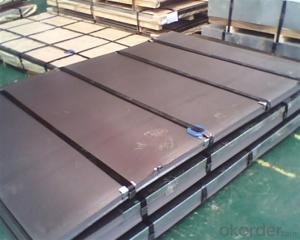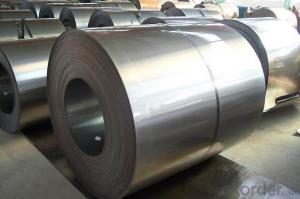Cold Rolled Steel in Sheets for Galvanizing
- Loading Port:
- China main port
- Payment Terms:
- TT OR LC
- Min Order Qty:
- 25 m.t.
- Supply Capability:
- 100000 m.t./month
OKorder Service Pledge
OKorder Financial Service
You Might Also Like
Product Name | Cold Rolled Sheet Coil |
Material | SPCC/SPCD/SPCE/DC01/ST12/ ST14/SPCD/DC03/DC04 ect. |
Grade Standard | JIS G3302, EN10142, ASTM653, ASTM95 |
Thickness | 0.15-3.5mm |
Width | 600mm-1500mm |
Coil ID | 508-610mm |
Coil OD | max 1500mm |
Weight | 3-10 Tons |
Tolerance | Thickness tolerance:+/-0.02mm; Width tolerance:+/-5mm |
Surface | No-skin passed or Skin passed, Tensile leveled |
Surface Treatment | Chromate/Unchromate passivation, fingerprint resistant treatment, oiled/unoiled |
Annual Output | 350,000MT |
Application | Construction, hardware, home applicances, interior decoration |
Classification | Designation | Characteristics | Main applications |
Commercial quality | SPCC SPCCT | Commercial quality suitable for bending fabrication and simple forming; this is the type in greatest demand. | Refrigerators, cabinets, power distribution baords and drums. |
Drawing quality | SPCD | Drawing quality second only to that of SPCEN. Excellent uniformity. | Automobile floor and roof panels. |
Deep-drawing quality | SPCE SPCF | Deep-drawing quality.With metallurgically controlled grain size, it retains its beautiful finish even after being deep-drawn. | Automobile fenders and quarter panels |
Extra deep-drawing quality | SPCG | Extra-low-carbon steel sheets with highest workability | Automobile internal panels and deep-drawn parts |
- Q:Is 440 steel relatively strong or weak?
- Its strong steel is rated by the precence of carbon in it. Higher carbon _ higher the price
- Q:What are the environmental impacts of producing steel coils?
- The production of steel coils has numerous environmental effects. Firstly, it entails the extraction of iron ore, which necessitates mining activities. These mining operations can result in deforestation, habitat destruction, and soil erosion. Furthermore, considerable amounts of energy are required for the extraction and processing of iron ore, contributing to greenhouse gas emissions and air pollution. Moreover, the production of steel coils involves various stages, including smelting and refining, which are energy-intensive and release significant quantities of carbon dioxide, sulfur dioxide, and nitrogen oxides. These emissions contribute to air pollution, acid rain, and climate change. Water consumption is also a noteworthy environmental impact. Steel production necessitates substantial volumes of water for cooling and processing purposes. This high demand for water can strain local water resources and potentially lead to water scarcity or pollution if not managed properly. Furthermore, the steel industry generates substantial quantities of waste and by-products, such as slag, dust, and sludge. Proper disposal and treatment of these waste materials are crucial to prevent soil and water contamination. Lastly, transportation plays a role in the environmental impact of steel coil production. The transportation of raw materials and finished products can result in carbon emissions and air pollution, particularly for long distances. To mitigate these environmental impacts, various measures can be implemented. Adopting more efficient production processes, such as recycling and utilizing renewable energy sources, can reduce energy consumption and emissions. Additionally, enhancing waste management practices, investing in water conservation technologies, and optimizing transportation logistics can help minimize the environmental footprint of steel coil production.
- Q:I'm getting my nose pierced, meaning that i have to keep the piercing in for a prolonged time. i've always had reactions when wearing sterling silver or fake earrings (i dont know what types of metal they were) after wearing it overnight. Will I get a reaction on my nose piercing if the stud is surgical steel?
- Surgical Steel Tongue Rings
- Q:How are steel coils used in the manufacturing of storage systems?
- Steel coils are used in the manufacturing of storage systems as they provide structural support and durability. These coils are commonly used to create the framework, shelves, and racks of storage systems, ensuring they can withstand heavy loads and maintain their shape over time. Additionally, steel coils may be used in the production of components like brackets or connectors, which further enhance the stability and functionality of storage systems.
- Q:The difference between aluminized color steel roll and ordinary color steel roll
- Ordinary color steel roll is a composite material, also known as color coated steel plate, is used in the continuous production line on the production line after surface degreasing, phosphating and other chemical coating treatment, painted with organic coatings, made by baking products. Both steel and organic materials are a little bit different. Both the mechanical strength of steel plate and easy molding performance, but also organic materials, good decoration, corrosion resistance.
- Q:How are steel coils used in the manufacturing of exhaust manifolds?
- Steel coils are used in the manufacturing of exhaust manifolds by being shaped and formed into the desired design and dimensions of the manifold. The coils are typically cut, bent, and welded together to create the necessary shape and structure of the exhaust manifold.
- Q:What is the role of steel coils in the manufacturing of storage racks?
- Steel coils play a critical role in the manufacturing of storage racks as they provide the raw material for creating the structural components of the racks. These coils are typically transformed through processes like cutting, bending, and welding to form the various parts of the racks, such as the upright frames, beams, and shelves. The strength and durability of steel make it an ideal material for storage racks, ensuring they can withstand heavy loads and provide long-lasting support for storing items efficiently.
- Q:What are the common size limitations for steel coils?
- The size limitations for steel coils can vary depending on the specific requirements of the industry or application. However, there are commonly followed general size limitations in the steel manufacturing and distribution industry. Steel coils can have a width ranging from as narrow as 0.25 inches (6.35 mm) to as wide as 72 inches (1828.8 mm). This wide range allows for versatility in various applications, including automotive parts and construction materials. The thickness of steel coils can vary significantly, usually ranging from 0.006 inches (0.15 mm) to 0.5 inches (12.7 mm). Thinner coils are often used when lighter weight and flexibility are required, while thicker coils are commonly used in heavy-duty applications that require strength and durability. Consideration should also be given to the weight of steel coils, especially for transportation and handling purposes. Steel coils can typically weigh anywhere from a few hundred pounds to several tons. The weight limitations depend on factors such as the size of the coil, the steel grade, and the transportation and storage equipment used. Additionally, there are limitations on the outer and inner diameter of steel coils. The outer diameter usually ranges from 24 inches (609.6 mm) to 72 inches (1828.8 mm), while the inner diameter can vary from 16 inches (406.4 mm) to 24 inches (609.6 mm). These dimensions are crucial for ensuring compatibility with processing equipment and storage racks. It is important to note that these size limitations are not fixed and can be customized based on specific requirements. Steel manufacturers and distributors often collaborate closely with their customers to determine the optimal size and dimensions of the coils, ensuring efficient handling and processing.
- Q:What is the average amount carbon emissions of steel per pound produced?
- Carbon okorder /... - Similar pages - Life-cycle energy and emissions of marine energy devices | Carbon ...Carbon dioxide emissions per unit mass of steel: 1.75 tCO2/tonne steel ; Total mass of steel in device: 665 tonnes ; Carbon dioxide emissions due to .
- Q:How are steel coils inspected for impact resistance?
- To ensure the durability and ability of steel coils to withstand external forces, they are commonly inspected for impact resistance using various methods. One such method is the drop test, where a steel coil is dropped from a specified height onto a hard surface, simulating the impact it may experience during transportation or handling. During the drop test, the coil is visually examined for visible signs of damage, such as dents, cracks, or deformations. Additionally, other examinations like ultrasonic testing or magnetic particle inspection may be conducted to detect hidden internal defects that could compromise its impact resistance. Another method employed to inspect steel coils for impact resistance is the pendulum test. This involves swinging a pendulum with a known weight and height to strike the surface of the coil. The amount of energy absorbed by the coil during the impact is measured and used to assess its resistance to impact. Furthermore, laboratory tests like Charpy impact testing may be conducted on steel coils to determine their resistance to sudden impacts. This test involves striking a notched sample of the coil with a pendulum hammer, measuring the energy absorbed by the sample, and evaluating its impact strength. Overall, a combination of drop tests, visual inspections, non-destructive testing methods, pendulum tests, and laboratory tests are employed to inspect steel coils for impact resistance. These inspections ensure that the coils meet the required standards and can endure the potential challenges they may face during transportation, storage, and usage.
1. Manufacturer Overview |
|
|---|---|
| Location | |
| Year Established | |
| Annual Output Value | |
| Main Markets | |
| Company Certifications | |
2. Manufacturer Certificates |
|
|---|---|
| a) Certification Name | |
| Range | |
| Reference | |
| Validity Period | |
3. Manufacturer Capability |
|
|---|---|
| a)Trade Capacity | |
| Nearest Port | |
| Export Percentage | |
| No.of Employees in Trade Department | |
| Language Spoken: | |
| b)Factory Information | |
| Factory Size: | |
| No. of Production Lines | |
| Contract Manufacturing | |
| Product Price Range | |
Send your message to us
Cold Rolled Steel in Sheets for Galvanizing
- Loading Port:
- China main port
- Payment Terms:
- TT OR LC
- Min Order Qty:
- 25 m.t.
- Supply Capability:
- 100000 m.t./month
OKorder Service Pledge
OKorder Financial Service
Similar products
New products
Hot products
Related keywords





























